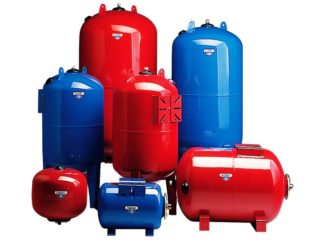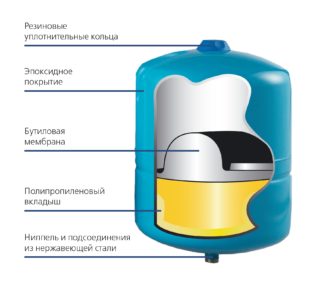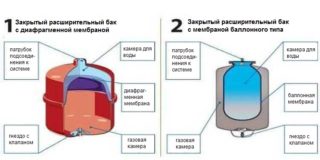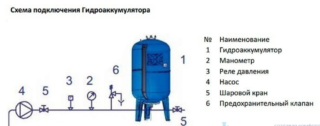In autonomous water supply systems, expansion tanks of different volumes are used. When they are included in the water supply system, it is possible to reduce the number of cycles of turning on and off the equipment and thus extend its service life.
Purpose of expansion tanks for water supply

The purpose of expansion tanks is to maintain constant pressure in the water supply system of a private or apartment building. Depending on the needs of the residents, you can select the required volume of the tank.
For the plumbing system, the greatest danger is water hammer. This is a sudden change in pressure in the pipes. Distinguish between positive water hammer, when the pressure rises sharply, and negative, in which case it decreases. If positive, a breakthrough of pipes from any material is possible, after which replacement will be required and the house will not be cut off from the water source for some time. More than 60% of pipeline damage cases are due to positive water hammer. It happens as follows: when a tap was opened in the house, a certain amount of water was used, then it was closed, the liquid in the pipes by inertia continues to flow in the direction of the tap, collides with the partition and begins to flow in the opposite direction. There are two waves - the opposite and the opposite. They collide and burst the pipe.
The use of a diaphragm tank prevents this situation, since the pump is switched off in advance, by a signal from the pressure sensor. The fluid velocity is no longer as high and is not capable of damaging the pipe material.
With the help of an expansion tank, you can create the necessary supply of water. The engine will not turn on again as long as the pressure inside is correct. In the event of a power outage, water will enter the house under the pressure that is created in the system.
In some cases, the membrane tank is installed in a self-contained apartment system to reduce the pressure of the centrally supplied water. The cold water pressure can be so strong that pipe connections in the heating system begin to leak. The membrane tank is a kind of obstacle and does not allow more liquid to enter the apartment than the boiler and pipes can withstand.
With the correct settings, you can achieve almost the same water pressure. If the owner of the equipment is interested in the long-term operation of the pump, he will adjust the sensors so that they work less often, but the pressure may temporarily decrease. In a private house, this leads to the fact that a person in the shower can get burned with hot water, because the pressure of cold water will decrease.
Principle of operation and device

The diaphragm tank consists of a metal body, which is treated with an anti-corrosion coating inside. It is divided into two parts, one of them is a rubber bulb, where water is collected, the other is filled with air.
When the liquid begins to flow, the pear expands and the air pressure inside increases. When the sensors fix the upper limit, the pump turns off, water enters the house under the influence of pressure. With a large flow of liquid, the equipment turns on again, since the pressure drops and the water pressure weakens for a short period of time.It is possible to configure the unit so that the head is always the same, but this will lead to more frequent starts and wear of the equipment.
The accumulator can be used separately, for example, if a submersible deep-water pump is installed. Also, the accumulator is included in the set of pumping stations. Their main disadvantage is that they lift liquid from a maximum of 8 meters. If the water mirror drops lower in the summer or for other reasons, you have to lower the immersion hose below. At the same time, the pump does not have enough power to lift the liquid up. In this case, the system cannot reach the upper pressure limit and the station works without shutting down. This sometimes leads to overheating of the equipment and the electrical winding burns out. It is expensive and unprofitable to change it, therefore it is recommended to buy a new pump.
It is cheaper to install a submersible pump and a separate membrane tank than buying a station with an ejector. Firstly, such equipment makes a lot of noise during operation, and secondly, it is expensive.
The bulb is attached internally with a threaded flange. It can be replaced if necessary. On the other side of the body there is a special nipple through which the amount of air can be adjusted using a bicycle pump. If you press on the nipple, the excess volume will come out. Some models use a nitrogen mixture.
Types of tanks
There are tanks that can only withstand cold water. They are made of rubber that can withstand temperatures from -10 to + 50 degrees. Rubber is suitable for drinking water as it does not emit harmful substances.
The storage tank for hot water systems is able to withstand temperatures up to 120 degrees. Manufacturing material - butyl synthetic rubber. Also suitable for drinking water.
For the accumulation of industrial water, a different brand of rubber is used. Temperature readings are similar to the previous ones.
The body can be made of stainless steel or durable plastic. The first varieties are more expensive, but more durable. Outside and inside are covered with paint.
Criterias of choice
First of all, the tank is selected based on the volume of water that can be stored there. On sale there are containers from 24 to 1000 liters. In this case, the volume of liquid takes up only 30% of the total. This is necessary to build up the required pressure.
A feature of small tanks is the absence of a nipple to remove excess air. This can be inconvenient to use. Larger tanks are better at maintaining a constant pressure in the system, have a nipple and are more versatile in service.
Depending on the available space, you can choose a horizontal or vertical model for installing the storage tank. The horizontal volume is always less, they can be mounted on the wall. The vertical ones have legs for installation, the volume of liquid in them is greater.
In addition to these two indicators, the choice is made taking into account the following criteria:
- the pressure that can be created in the system thanks to the membrane tank;
- is it possible to periodically change the membrane or is it non-removable;
- is it possible to store drinking water or rubber is intended only for technical liquid;
- case material - steel or plastic.
For a family of 2 - 3 people, a container with a volume of up to 25 liters is sufficient. If there are more people and a pump is installed that pumps about 3.5 tons of water per hour, you can put a container with a volume of 50 liters.At a very high flow rate, for example, in an apartment building, a 100 liter tank is suitable.
Installation steps
After choosing a model, you must be guided by the rules by which the installation is carried out:
- the diameter of the pipes must be the same or larger than the inlet of the tank;
- collapsible fittings are used;
- it is necessary to choose the right place so that it is convenient to carry out repair work;
- the metal case is grounded;
- the tank is installed closer to the pump, between them there should be no other equipment that can increase the pressure in the system.
Installation steps:
- Installation of filters on the pump that will pump water from the well. This is necessary so that the sand does not accumulate in the membrane and does not wear it away.
- A five-outlet part is installed, to which a pressure gauge, relays and protection sensors will be connected, as well as a ball valve-shutoff and a tee.
- The container is mounted on a wall or installed on legs and screwed in with anchor bolts.
- A flexible hose connects the tank and the five-outlet part.
- A pressure gauge and sensors are installed.
It is advisable to provide for the possibility of draining water in case of emergency repairs.
Operation and maintenance
The settings must be made before commissioning. To do this, the water is completely drained and the pressure is measured with a manometer. If it does not correspond to the required one, with the help of an automobile pump, it is brought to the required indicators. The difference in maximum and minimum pressure must be within 1.5 bar.
The service is carried out in order to check the pressure indicator in the air or gas compartment. New containers do not require detailed inspection. In older systems, the casing may crack or the integrity of the membrane may be compromised and must be replaced.
The prices for a membrane expansion tank for water supply depend on the materials of manufacture, the brand of the manufacturer, as well as the potential volume of water that can be stored inside. The kit may include mounting parts, pressure gauge and dry-running relay.











Thank you for the lesson.
I have a question how to measure the pressure of switching on the pump on cold water supply (lower pressure)
And another question: as far as I understand, to determine the membrane rupture, it is enough to turn on the pump frequently, and when you unscrew the nipple cap for pumping the accumulator, you will see a clear flow of water without any bottles.
In general, as a beginner, I have a lot of information about everything at once.